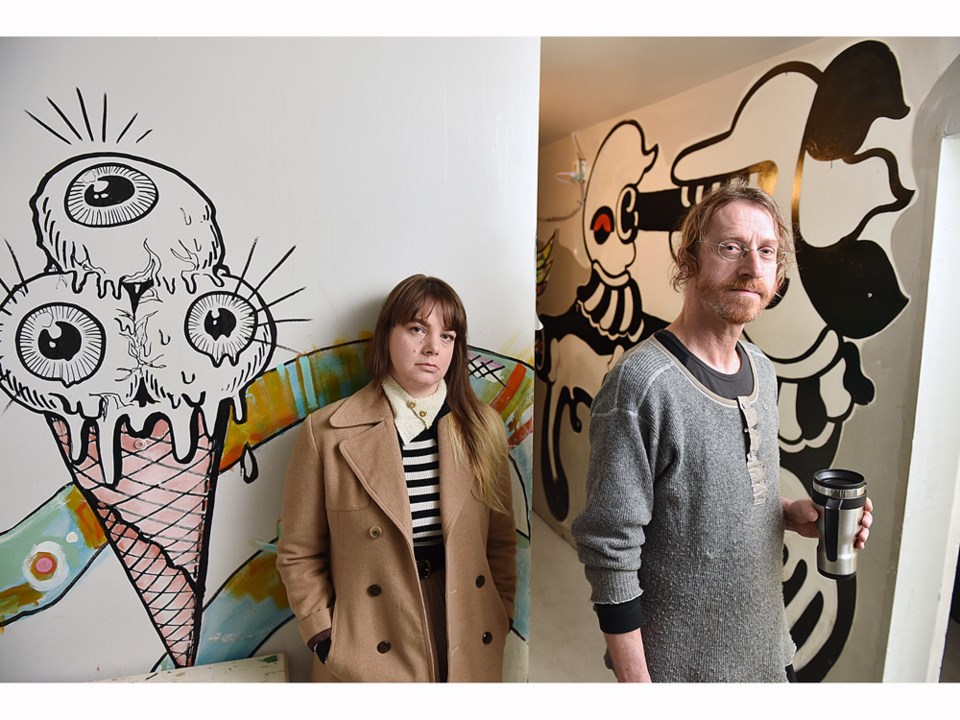Whether he knew it at the time, musician Adrian Teacher seemed to have seen the writing on the wall when his band, Adrian Teacher and the Subs, penned the title track to its 2016 album, Terminal City.
“The woman smiled at me and said: ‘Is there anything you’d like to know about the neighbourhood?’” the song goes. “I told her that I’d lived here for 10 years./We all know that/I cannot save it!”
Two years later, that reality is here and now, as Teacher and dozens of other artists and musicians are losing their space to create, practise and hone their crafts.
The Red Gate Arts Society has to be out of its current location at 855 East Hastings by May 31. A development application is currently before the city to change the land’s designation from manufacturing to retail.
Teacher has rehearsed at various Red Gate facilities since 2003. About 80 musicians and artists are affected by the impending closure.
“It may even force me into thinking about giving up the idea of music — not necessarily the idea of playing music, but the idea of being in a rock band and playing loud music,” Teacher told the Courier Monday. “It’s pushed me to the brink. We’ve had to move so many times and been in so many terrible jam spaces. It’s like I don’t want to do this anymore.”
Society director Jim Carrico told the Courier the building has been under a month-to-month agreement with Low Tide Properties — the real estate company headed up by Lululemon founder Chip Wilson — for about two years since the previous lease expired.
With an expired lease and monthly arrangement, Carrico isn’t necessarily surprised he’s losing what will be his fourth arts space in the last three decades.
“Each time was a very similar situation, this isn’t new,” Carrico said. “The building was bought by a developer and we were given notice to leave and all the people and all their stuff moved to another building. It’s been more or less continuous going back to the 1980s.”
What has surprised Carrico in his current situation, however, is the going rate for another spot in Vancouver and the dearth of options he’s facing. He pays about $7,600 monthly for 7,000 square feet, outside of more than $5,000 in other yearly licensing fees.
Carrico is looking around the Clark Drive area and other points east, where costs are double that regardless of location or building quality. An older building on Main Street and Third Avenue had an asking price of $38,000 monthly for 19,000 square feet.
“It’s very expensive, so the young musicians, they’re not going to pay that rent — they’re going to go to Montreal and that’s a tragedy,” Carrico said. “The people that you really want to stay, they’re not going to complain, they’re not going to write letters to city hall or protest. They’re just going to leave and that’s what they are doing.”
Carrico charges about $1.70 per square foot in rooms ranging in size between 100 and 350 square feet. Other rehearsal spaces in Vancouver are charging two to three times that price.
Like Carrico, Teacher is also witnessing an exodus of artistic talent.
“You’re seeing it all the time. I’m seeing kids who are 22 and 23 who are saying, ‘Well, I’ve given up here. I’m going to Oakland or to Montreal.’ They leave because they can’t even afford living in an apartment let alone having a jam space.”
Wes Regan is acutely aware of that pinch. Now a social planner with the city, Regan moved to Vancouver 20 years ago to pursue a career in music. He recorded an album at the previous Red Gate location near Victory Square.
The first red flags he saw for artists was the closure of popular indie — and sometimes dingy — haunts such as Richards on Richards, the Starfish Room, the Columbia, the Brickyard and the Picadilly Pub. Outside of the Starfish Room, all of those venues closed in the last 10 years.
Now, the pressure is on the places where the spark of creation first takes root.
“It makes it next to impossible if you don’t have the money to buy a place or pay for regular rentals at rehearsal spots for young people who are just starting out,” said Regan, 38. “They need these dirt cheap types of spaces.”
Regan said city staff spanning several departments are trying to reverse that trend: planning staff are reviewing commercial land use policies, small business and retail regulations are being examined and social planners are looking to San Francisco, England, Rome and Paris for best practices in those locales.
Some of the ideas turned up so far include:
- Establishing “legacy businesses.” Cities give that designation to long-standing bars, restaurants and venues to protect their place in a neighbourhood when subsequent development moves in.
- Hybrid businesses that combine non- and for-profit models to allow more flexibility for venues to receive outside funding and protections.
- Putting the onus on developers, rather than venue owners, when covering soundproofing costs.
“This is not to stop new businesses from coming into an area… it’s more about the cultural practices in neighbourhoods that are important,” Regan said.
Carrico has some ideas too, and he’s in the process of lobbying for them. He wants property taxes waived for culturally significant properties and zoning protections — similar to what the Agricultural Land Reserve does for farm land — in place for the arts sector.
“When you take a space and fill it with interesting people and let them go do what they want it improves the overall quality of life in a city — it’s endlessly rewarding,” Carrico said.



